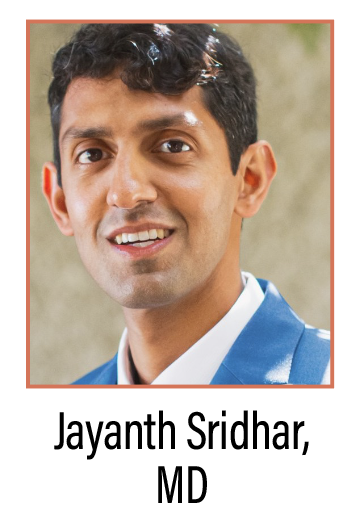 |
|
Bio Dr. Sridhar serves as Retina Specialist Magazine’s Social Media Ambassador. He’s an associate professor of clinical ophthalmology at Bascom Palmer Eye Institute, Miami. DISCLOSURE: Dr. Sridhar is a consultant to Alcon, DORC, Genentech/Roche and |
Sermo and LiveWorld recently published results of a survey of more than 200 physicians and more than 50 pharmaceutical marketers that demonstrated the impact social media may ultimately have on physician prescribing patterns.1
Nearly all of the marketers (94 percent) said that social media was a critical channel for reaching health-care providers. And 57 percent of physicians said that their initial perception of a medication had been previously changed by social media content.
Along the same lines, 90 percent of the marketers stated that social media was a formal component of their 2023 budget, with half of these budgets increasing yearly.
A natural progression
This shouldn’t surprise us, nor should we condemn it. While direct-to-patient marketing via social media raises a host of legal and ethical questions,2 one could simply view the transition to more digital interactions between pharma and physicians as natural, complementing previously compliant office visits, interfacing at conferences and mail communications.
Still, it’s incumbent for physicians—and, in the case of this column, retinal specialists specifically—to think carefully about how we source our information on social media.
According to the previously mentioned survey, physicians choose other physicians as influencers based on, in equal parts, their credentials, their knowledge of a topic and their relatable content. While these factors seem like good reasons to put more trust in a key opinion leader (KOL), none of them necessarily correlate with scientific accuracy and merit when evaluating new medications. Despite this, KOL influencers have become a major part of pharmaceutical strategy, with 56 percent of the marketers surveyed saying they’re including influencers in their 2023 plans.
Some ground rules
Responsibility goes two ways, both for the information provider and the recipient. For physicians who are KOL influencers (or who are budding digital KOLs, cultivating a careful social media presence to build their personal brands), it’s reasonable to lay out a few basic ground rules.
First, all physicians posting information related to a drug or trial results should be open about any financial disclosures. It’s a requirement for continuing medical education programs and should be part of the transparency between all of us as colleagues.
Second, physicians should understand that while friending or connecting with our pharma partners is inbounds and part of today’s modern world, they should take care to vet and take responsibility for any information before they repost and retweet drug or device content.
Finally, separate church and state. Leave patients out of the fray. If connecting on a platform with patients (for example, a practice Facebook page), it’s almost certainly inappropriate to post content promoting a specific product, given the concerns about direct-to-patient pharmaceutical marketing.
Bottom line
Social media has democratized the retina specialist’s ability to become a KOL and build their personal brand in rapid-fire fashion. For those interested in embracing this opportunity, let’s do it in a mindful, professionally respectful manner that follows ethical standards so we don’t fall prey as a community to pharmaceutical digital marketing group-think. RS
REFERENCES
1. Survey Finds 57% of U.S. physicians have changed their perception of a medication as a result of info on social media [press release]. New York, NY; Sermo and LiveWorld; February 15, 2023. Available at: https://www.businesswire.com/news/home/20230215005061/en/Survey-Finds-57-of-U.S.-Physicians-Have-Changed-Their-Perception-of-a-Medication-as-a-Result-of-Info-on-Social-Media
2. Sridhar J. Current digital direct-to-consumer advertising—The tip of the iceberg. JAMA Ophthalmol. 2022;140:642-643.



